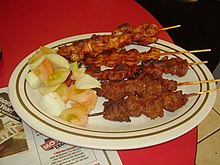| This article is part of a series in |
| Culture of Nigeria |
|---|
 |





Nigerian cuisine consists of dishes or food items from the hundreds of Native African ethnic groups that comprises Nigeria.[1][2] Like other West African cuisines, it uses spices and herbs with palm oil or groundnut oil to create deeply flavored sauces and soups.[3]
Nigerian feasts can be colourful and lavish, while aromatic market and roadside snacks cooked on barbecues or fried in oil are in abundance and varied.[4] Bushmeat is also consumed in Nigeria. The brush-tailed porcupine and cane rats are the most popular bushmeat species in Nigeria.[5][6][7][8]
Tropical fruits such as watermelon, pineapple, coconut, banana, orange and mango are mostly consumed in Nigeria.[9][10][11][12]
Nigerian cuisine, like many West African cuisines, is known for being savoury and spicy.
- ^ Oyibo, Emmanuel (2020-04-15). "Top 20 Nigerian Foods That Will Blow Your Taste Buds". Chef's Pencil. Retrieved 2022-05-17.
- ^ "Nigerian Food: 16 Popular and Traditional Dishes to Try". Nomad Paradise. 2020-08-10. Retrieved 2022-05-17.
- ^ "Facts about Nigerian Soup". Ofefoods Limited. 2021-07-08. Retrieved 2022-05-17.
- ^ Tamara (2019-12-25). "Nigeria cuisines". Tamcuisine. Retrieved 2022-08-31.
- ^ Jori, F.; Edderai, D.; Houben, Patrick; Paoletti, M. (7 January 2005). "Potential of Rodents for Minilivestock in Africa". Ecological Implications of Minilivestock. CRC Press. pp. 39–60. doi:10.1201/9781482294439-9. ISBN 9780429078590.
- ^ Jori, F.; Edderai, D.; Houben, P. (2005). "Potential of rodents for minilivestok in Africa". In Maurizio, M. G. (ed.). Ecological Implications of Minilivestock. Enfield, NH: Science Publishers. pp. 25–45. ISBN 1-57808-339-7.
- ^ Friant, Sagan; Paige, Sarah B.; Goldberg, Tony L. (2015-05-22). "Drivers of Bushmeat Hunting and Perceptions of Zoonoses in Nigerian Hunting Communities". PLOS Neglected Tropical Diseases. 9 (5): e0003792. doi:10.1371/journal.pntd.0003792. ISSN 1935-2735. PMC 4441483. PMID 26001078.
- ^ Kamgaing, Towa Olivier William; Dzefack, Zeun's Célestin Brice; Yasuoka, Hirokazu (2019). "Declining Ungulate Populations in an African Rainforest: Evidence From Local Knowledge, Ecological Surveys, and Bushmeat Records". Frontiers in Ecology and Evolution. 7. doi:10.3389/fevo.2019.00249. ISSN 2296-701X.
- ^ Oktay, Serdar; Sadıkoğlu, Saide (June 2018). "The gastronomic cultures' impact on the African cuisine". Journal of Ethnic Foods. 5 (2): 140–146. doi:10.1016/j.jef.2018.02.005.
- ^ Fadeiye, E. O.; Popoola, B. R.; Emuoke, D. K.; Adeoye, T. A.; Ogundana, M. T. (2019). "Factors Influencing Fruit Consumption Among Undergraduates in Obafemi Awolowo University, Ile-Ife, Osun State, Nigeria". Ife Journal of Agriculture. 31 (2).
- ^ "Nigerian delicacies". www.mynigeria.com. Retrieved 2022-05-17.
- ^ Onyeakagbu, Adaobi (2022-10-25). "You probably didn't know the names of these popular Nigerian fruits". Pulse Nigeria. Retrieved 2022-12-10.